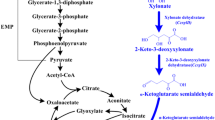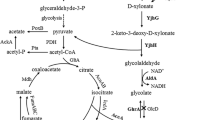Abstract
Xylitol is an important functional sugar alcohol which is widely used in industries. To efficiently produce xylitol from xylose by xylose reductase in a single step, the coupled system and the coexpression system using xylose reductase (XR) from Rhizopus oryzae and glucose dehydrogenase (GDH) from Exiguobacterium sibiricum were constructed, the latter of which was used for cofactor regeneration. One hundred fifty grams/liter of xylose could be fully converted to xylitol by employing the two-enzyme coupled system with cell-free extract, and xylitol productivity of 21.2 g/L/h was reached by biotransformation in vitro. The whole-cell biocatalyst coexpressing xylose reductase and glucose dehydrogenase was successfully used to synthesize xylitol via enzymatic reduction of xylose. After optimization of the induction condition, the enzyme activity reached 1533 U/L. Two hundred grams/liter of xylose could be completely converted to xylitol, and the highest xylitol productivity of 6.37 g/L/h was obtained under the optimal transformation conditions. Thus, recombinant Escherichia coli coexpressing xylose reductase and glucose dehydrogenase is a promising candidate for xylitol production from xylose.










Similar content being viewed by others
References
Albuquerque, T. L. D., Jr, I. J. D. S., Macedo, G. R. D., & Rocha, M. V. P. (2014). Biotechnological production of xylitol from lignocellulosic wastes: a review. Process Biochemistry, 49(11), 1779–1789. https://doi.org/10.1016/j.procbio.2014.07.010.
Granström, T. B., Izumori, K., & Leisola, M. (2007). A rare sugar xylitol. Part I: the biochemistry and biosynthesis of xylitol. Applied Microbiology and Biotechnology, 74(2), 277–281. https://doi.org/10.1007/s00253-006-0761-3.
Li, Z., Guo, X. X., Feng, X. D., & Li, C. (2015). An environment friendly and efficient process for xylitol bioconversion from enzymatic corncob hydrolysate by adapted Candida tropicalis. Chemical Engineering Journal, 263, 249–256. https://doi.org/10.1016/j.cej.2014.11.013.
Su, B., Wu, M., Zhang, Z., Lin, J., & Yang, L. (2015). Efficient production of xylitol from hemicellulosic hydrolysate using engineered Escherichia coli. Metabolic Engineering, 31, 112–122. https://doi.org/10.1016/j.ymben.2015.07.003.
Murthy, G. S., Sridhar, S., Sunder, M. S., Shankaraiah, B., & Ramakrishna, M. (2005). Concentration of xylose reaction liquor by nanofiltration for the production of xylitol sugar alcohol. Separation and Purification Technology, 44(3), 205–211. https://doi.org/10.1016/j.seppur.2005.01.007.
Rafiqul, I. S. M., & Sakinah, A. M. M. (2013). Processes for the production of xylitol—a review. Food Reviews International, 29(2), 127–156. https://doi.org/10.1080/87559129.2012.714434.
Dasgupta, D., Bandhu, S., Adhikari, D. K., & Ghosh, D. (2017). Challenges and prospects of xylitol production with whole cell bio-catalysis: a review. Microbiological Research, 197, 9–21. https://doi.org/10.1016/j.micres.2016.12.012.
Mohamad, N. L., Kamal, S. M. M., & Mokhtar, M. N. (2015). Xylitol biological production: a review of recent studies. Food Reviews International, 31(1), 74–89. https://doi.org/10.1080/87559129.2014.961077.
Pratter, S. M., Eixelsberger, T., & Nidetzky, B. (2015). Systematic strain construction and process development: xylitol production by Saccharomyces cerevisiae expressing Candida tenuis xylose reductase in wild-type or mutant form. Bioresource Technology, 198, 732–738. https://doi.org/10.1016/j.biortech.2015.09.046.
Rafiqul, I. S. M., & Sakinah, A. M. M. (2012). A perspective bioproduction of xylitol by enzyme technology and future prospects. International Food Research Journal, 19(2), 4405–4408.
Ramesh, S., Muthuvelayudham, R., Kannan, R. R., & Viruthagiri, T. (2013). Response surface optimization of medium composition for xylitol production by Debaryomyces hansenii var hansenii using corncob hemicellulose hydrolysate. Chemical Industry and Chemical Engineering Quarterly, 19(3), 377–384. https://doi.org/10.2298/CICEQ120315072R.
Su, B., Wu, M., Lin, J., & Yang, L. (2013). Metabolic engineering strategies for improving xylitol production from hemicellulosic sugars. Biotechnology Letters, 35(11), 1781–1789. https://doi.org/10.1007/s10529-013-1279-2.
Jin, L. Q., Zhao, N., Liu, Z. Q., Liao, C. J., Zheng, X. Y., & Zheng, Y. G. (2017). Enhanced production of xylose from corncob hydrolysis with oxalic acid as catalyst. Bioprocess and Biosystems Engineering, 9, 1–8. https://doi.org/10.1007/s00449-017-1843-6.
Khattab, S. M. R., Watanabe, S., Saimura, M., & Kodaki, T. (2011). A novel strictly NADPH-dependent Pichia stipitis xylose reductase constructed by site-directed mutagenesis. Biochemical and Biophysical Research Communications, 404(2), 634–637. https://doi.org/10.1016/j.bbrc.2010.12.028.
Woodyer, R., Simurdiak, M., Wa, V., & Zhao, H. (2005). Heterologous expression, purification, and characterization of a highly active xylose reductase from Neurospora crassa. Applied and Environmental Microbiology, 71(3), 1642–1647. https://doi.org/10.1128/AEM.71.3.1642-1647.2005.
Jang, S. H., & Kang, H. Y. (2003). Complete in vitro conversion of D-xylose to xylitol by coupled xylose reductase and formate dehydrogenase. Journal of Microbiology and Biotechnology, 13(4), 501–508.
Wu, H., Tian, C., Song, X., Liu, C., Yang, D., & Jiang, Z. (2013). Methods for the regeneration of nicotinamide coenzymes. Green Chemistry, 15(7), 1773–1789. https://doi.org/10.1039/c3gc37129h.
Neuhauser, W., Steininger, M., Haltrich, D., Kulbe, K. D., & Nidetzky, B. (1998). A pH-controlled fed-batch process can overcome inhibition by formate in NADH-dependent enzymatic reductions using formate dehydrogenase-catalyzed coenzyme regeneration. Biotechnology and Bioengineering, 60(3), 277–282. https://doi.org/10.1002/(SICI)1097-0290(19981105)60:3<277::AID-BIT2>3.0.CO;2-E.
Nidetzky, B., Neuhauser, W., Haltrich, D., & Kulbe, K. D. (1996). Continuous enzymatic production of xylitol with simultaneous coenzyme regeneration in a charged membrane reactor. Biotechnology and Bioengineering, 52(3), 387–396. https://doi.org/10.1002/(SICI)1097-0290(19961105)52:3<387::AID-BIT4>3.0.CO;2-G.
Zheng, Y. G., Yin, H. H., Yu, D. F., Chen, X., Tang, X. L., Zhang, X. J., Xue, Y. P., Wang, Y. J., & Liu, Z. Q. (2017). Recent advances in biotechnological applications of alcohol dehydrogenases. Applied Microbiology and Biotechnology, 101(3), 987–1001. https://doi.org/10.1007/s00253-016-8083-6.
Liu, Z. Q., Wu, L., Zheng, L., Wang, W. Z., Zhang, X. J., Jin, L. Q., & Zheng, Y. G. (2018). Biosynthesis of tert-butyl (3R,5S)-6-chloro-3,5-dihydroxyhexanoate by carbonyl reductase from Rhodosporidium toruloides in mono and biphasic media. Bioresource Technology, 249, 161–167. https://doi.org/10.1016/j.biortech.2017.09.204.
Liu, Z. Q., Dong, S. C., Yin, H. H., Xue, Y. P., Tang, X. L., Zhang, X. J., He, J. Y., & Zheng, Y. G. (2017). Enzymatic synthesis of an ezetimibe intermediate using carbonyl reductase coupled with glucose dehydrogenase in an aqueous-organic solvent system. Bioresource Technology, 229, 26–32. https://doi.org/10.1016/j.biortech.2016.12.098.
Liu, Z. Q., Wu, L., Zhang, X. J., Xue, Y. P., & Zheng, Y. G. (2017). Directed evolution of carbonyl reductase from Rhodosporidium toruloides and its application in stereoselective synthesis of tert butyl (3R,5S)-6-chloro-3,5-dihydroxyhexanoate. Journal of Agricultural and Food Chemistry, 65(18), 3721–3729. https://doi.org/10.1021/acs.jafc.7b00866.
Liu, Z. Q., Hu, Z. L., Zhang, X. J., Tang, X. L., Cheng, F., Xue, Y. P., Wang, Y. J., Wu, L., Yao, D. K., Zhou, Y. T., & Zheng, Y. G. (2017). Large-scale synthesis of tert-butyl (3R,5S)-6-chloro-3,5-dihydroxyhexanoate by a stereoselective carbonyl reductase with high substrate concentration and product yield. Biotechnology Progress, 33(3), 612–620. https://doi.org/10.1002/btpr.2460.
Luo, X., Wang, Y. J., Shen, W., & Zheng, Y. G. (2016). Activity improvement of a Kluyveromyces lactis aldo-keto reductase KlAKR via rational design. Journal of Biotechnology, 224, 20–26. https://doi.org/10.1016/j.jbiotec.2016.03.008.
Zhang, M., Jiang, S. T., Zheng, Z., Li, X. J., Luo, S. Z., & Wu, X. F. (2015). Cloning, expression, and characterization of a novel xylose reductase from Rhizopus oryzae. Journal of Basic Microbiology, 55(7), 907–921. https://doi.org/10.1002/jobm.201400786.
Liu, Z. Q., Ye, J. J., Shen, Z. Y., Hong, H. B., Yan, J. B., Lin, Y., Chen, Z. X., Zheng, Y. G., & Shen, Y. C. (2015). Upscale production of ethyl (S)-4-chloro-3-hydroxybutanoate by using carbonyl reductase coupled with glucose dehydrogenase in aqueous-organic solvent system. Applied Microbiology and Biotechnology, 99(5), 2119–2129. https://doi.org/10.1007/s00253-014-6245-y.
Galkin, A., Kulakova, L., Yoshimura, T., Soda, K., & Esaki, N. (1997). Synthesis of optically active amino acids from alpha-keto acids with Escherichia coli cells expressing heterologous genes. Applied and Environmental Microbiology, 63(12), 4651–4656.
Hashimoto, S., & Ozaki, A. (1999). Whole microbial cell processes for manufacturing amino acids, vitamins or ribonucleotides. Current Opinion in Biotechnology, 10(6), 604–608. https://doi.org/10.1016/S0958-1669(99)00041-5.
Wu, X., Gou, X., & Chen, Y. (2015). Enzymatic preparation of t-butyl-6-cyano-(3R,5R)-dihydroxyhexanoate by a whole-cell biocatalyst co-expressing carbonyl reductase and glucose dehydrogenase. Process Biochemistry, 50(1), 104–110. https://doi.org/10.1016/j.procbio.2014.10.023.
Volontè, F., Marinelli, F., Gastaldo, L., Sacchi, S., Pilone, M. S., Pollegioni, L., & Molla, G. (2008). Optimization of glutaryl-7-aminocephalosporanic acid acylase expression in E. coli. Protein Expression and Purification, 61(2), 131–137. https://doi.org/10.1016/j.pep.2008.05.010.
Wang, Y. H., Jing, C. F., Yang, B., Mainda, G., Dong, M. L., & Xu, A. L. (2005). Production of a new sea anemone neurotoxin by recombinant Escherichia coli: optimization of culture conditions using response surface methodology. Process Biochemistry, 40(8), 2721–2728. https://doi.org/10.1016/j.procbio.2004.12.024.
Pan, H., Xie, Z., Bao, W., & Zhang, J. (2008). Optimization of culture conditions to enhance cis-epoxysuccinate hydrolase production in Escherichia coli by response surface methodology. Biochemical Engineering Journal, 42(2), 133–138. https://doi.org/10.1016/j.bej.2008.06.007.
Hollmann, F., Arends, I. W. C. E., & Buehler, K. (2010). Biocatalytic redox reactions for organic synthesis: nonconventional regeneration methods. Chemcatchem, 41(42), 762–782. https://doi.org/10.1002/cctc.201000069.
Chen, X., Liu, Z. Q., Lin, C. P., & Zheng, Y. G. (2016). Chemoenzymatic synthesis of (S)-duloxetine using carbonyl reductase from Rhodosporidium toruloides. Bioorganic Chemistry, 65, 82–89. https://doi.org/10.1016/j.bioorg.2016.02.002.
Zhang, J., Tao, S., Zhang, B., Wu, X., & Chen, Y. (2014). Microparticle-based strategy for controlled release of substrate for the biocatalytic preparation of L-homophenylalanine. ACS Catalysis, 4(5), 1584–1587. https://doi.org/10.1021/cs4011919.
Kim, H., Lee, H. S., Park, H., Lee, D. H., Boles, E., Chung, D., & Park, Y. C. (2017). Enhanced production of xylitol from xylose by expression of Bacillus subtilis arabinose:H+ symporter and Scheffersomyces stipitis xylose reductase in recombinant Saccharomyces cerevisiae. Enzyme and Microbial Technology, 107, 7–14. https://doi.org/10.1016/j.enzmictec.2017.07.014.
Wang, X. X., Lin, C. P., Zhang, X. J., Liu, Z. Q., & Zheng, Y. G. (2018). Improvement of a newly cloned carbonyl reductase and its application to biosynthesize chiral intermediate of duloxetine. Process Biochemistry, 70, 124–128. https://doi.org/10.1016/j.procbio.2018.04.010.
Acknowledgments
The authors gratefully acknowledge the National Natural Science Foundation of China (No. 21602199; No. 31401527) and the Research Program of Science and Technology Department of Zhejiang Province (No. 2015C32052).
Author information
Authors and Affiliations
Corresponding author
Ethics declarations
Conflict of Interest
The authors declare that they have no conflicts of interest.
Ethical Statement
The article does not contain any studies with human participants performed by any of the authors.
Rights and permissions
About this article
Cite this article
Jin, LQ., Xu, W., Yang, B. et al. Efficient Biosynthesis of Xylitol from Xylose by Coexpression of Xylose Reductase and Glucose Dehydrogenase in Escherichia coli. Appl Biochem Biotechnol 187, 1143–1157 (2019). https://doi.org/10.1007/s12010-018-2878-0
Received:
Accepted:
Published:
Issue Date:
DOI: https://doi.org/10.1007/s12010-018-2878-0




